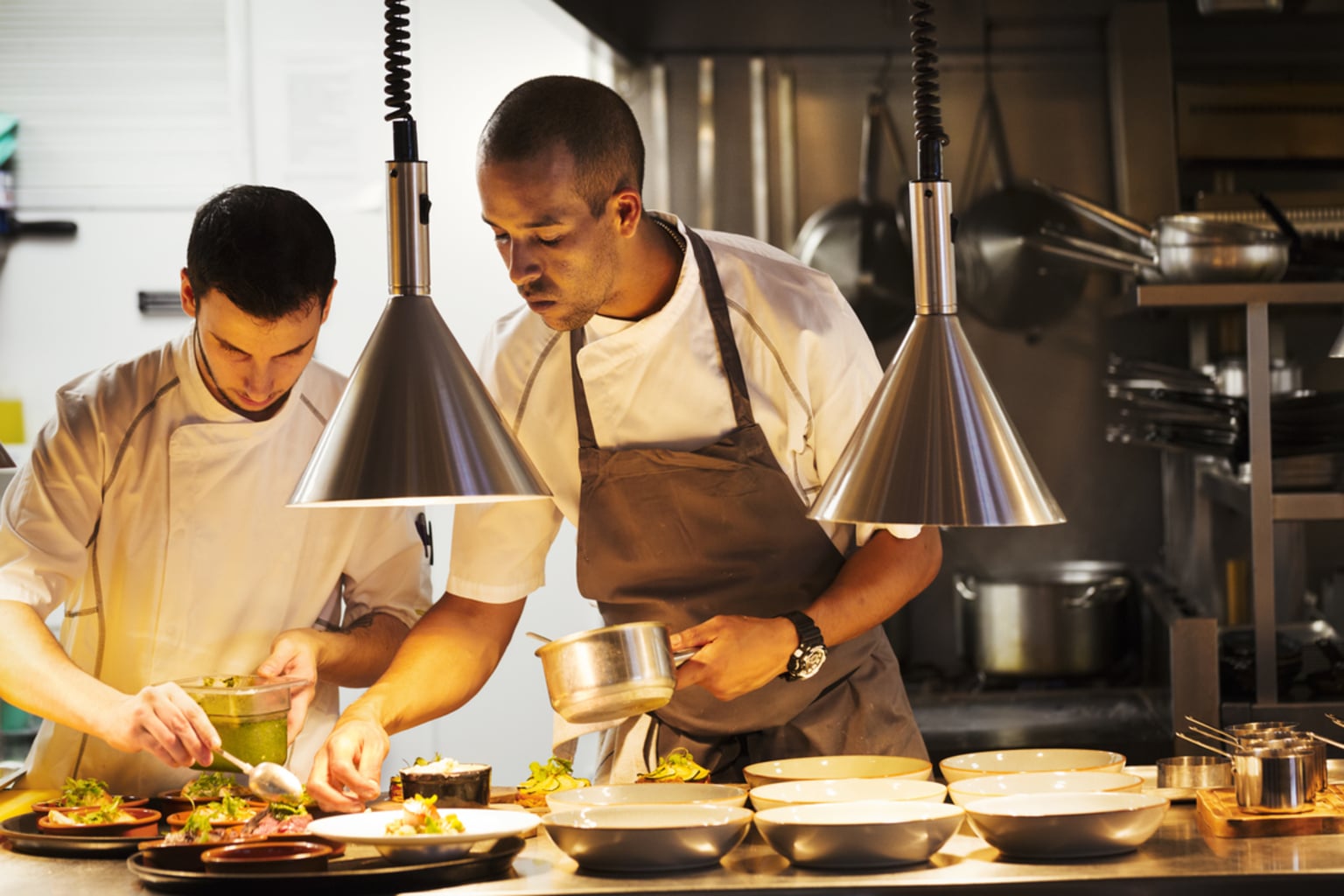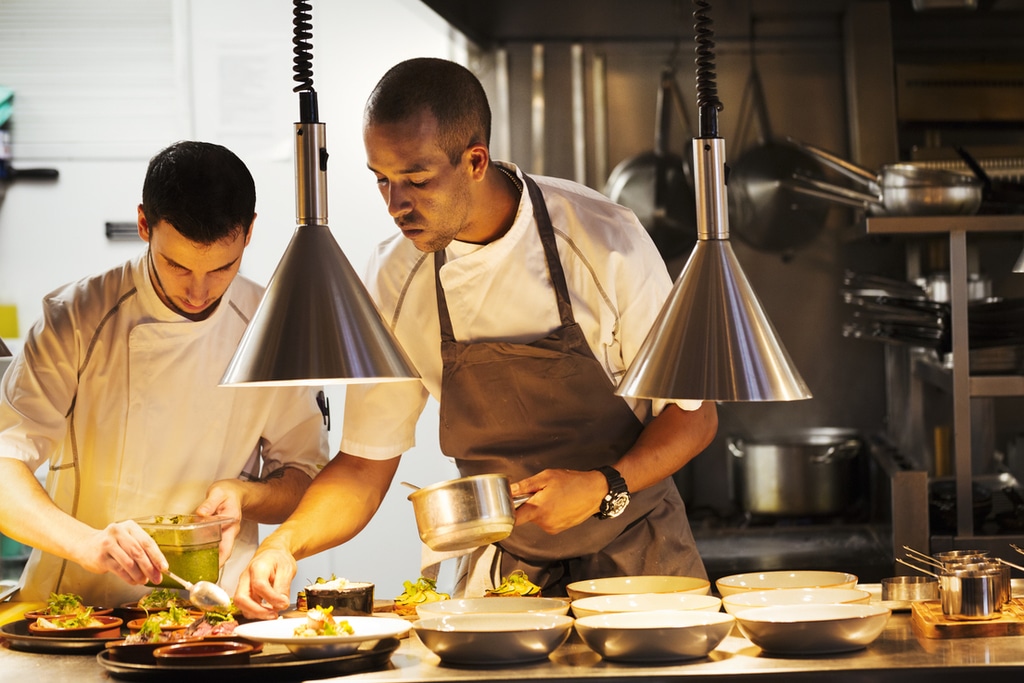
As a restaurateur, you want to provide your customers with the best dining experience you can. From placing orders to delivering the dishes and processing the bill, each step should be smooth and convenient. Sometimes that means making an investment in the right software, which can help make all of this possible.
When it comes to meal ordering and preparation, kitchen display systems (KDS) are replacing the need for handwritten and verbally communicated tickets in restaurants. A kitchen display screen shows the pending orders that are being prepared and streamlines communication between the front-of-the-house (FOH) and back-of-the-house (BOH) sections of a restaurant.
What are the differences between the back-of-the-house and front-of-the-house?
Simply put, FOH is all of the areas that a customer is exposed to during their dining experience, like the host area and dining area. The BOH is the area customers will not typically see, such as the kitchen where food is prepared and plated (unless the restaurant features an open kitchen), as well as where the administrative work occurs.
A kitchen display system makes it easy for staff members in the FOH to communicate with staff in the BOH, and vice versa. When you have an ongoing and easy dialogue between both sections of your restaurant, your staff will be happier and so will your customers.
So what do you need to know about kitchen display systems? We’ll take a look at the following:
- What is a kitchen display system?
- How can kitchen display system software help?
- What are the different parts of a kitchen display system?
- How do I choose a kitchen display system?
The kitchen display system you choose can make or break your restaurant’s daily operations.Are you ready to take a deep dive into the options available to you? Let’s get started!
What is a kitchen display system?
A kitchen display system is a digital screen that displays order tickets by connecting to the restaurant’s POS (point-of-sale) system. This system replaces handwritten or verbal tickets and reduces human error, all while monitoring the time it takes to prepare each dish.
Essentially, kitchen display systems digitize the order preparation process for staff in the BOH
How can kitchen display system software help your restaurant?
Kitchen display system software can help streamline your restaurant’s day-to-day operations in more ways than one. From guaranteeing more accurate tickets to minimizing paper waste, your restaurant’s order-taking and preparation processes will become smoother and lead to more satisfied customers.
Here are the top ways that having a kitchen display system can help:
Order Accuracy
You can send orders from any FOH device to the kitchen with the press of a button. Tickets will then appear in the kitchen on a large monitor. This helps reduce human error. Even more, any mistakes that are made while taking orders can easily be corrected in the POS system and will automatically update on the BOH screen.
Efficiency
Your servers won’t have to spend time giving copies of the order tickets to each area of the restaurant (kitchen staff, cashier, etc.) because the order will be immediately delivered to the appropriate staff. You can even set up a kitchen display screen at each individual station.
Even more, when orders are finished in the kitchen, servers can be notified to come pick up the orders and deliver them to the table. Your staff will definitely appreciate the system’s ease of use.
Environmental Consciousness
Because you’ve upgraded to a kitchen display screen, there will be less paper and printing in your restaurant, which will lead to less waste!
Kitchen display systems have many benefits. Above all else, you want your customers to be happy and to receive the correct order in a timely manner. Because their orders will be sent directly to the kitchen staff, your efficiency will increase and fewer errors will occur. This will be beneficial to both your customers and your staff.
What are the different parts of a kitchen display system?
When shopping around for a KDS, be on the lookout for certain features that can benefit your restaurant if they’re part of the package. Hardware and software are both important to note when you implement the system in your restaurant.
Let’s take a look at the hardware and software that come with a KDS.
Hardware
The hardware components of a kitchen display system typically include your tablet, a printer (at times), BOH screens, and a bump bar.
- Tablet. This is the touchscreen display you’ll use to send orders to the kitchen. It will typically be associated with your restaurant’s POS system.
- Printer. Even with processes being automated, kitchen printer systems are still popular in the restaurant industry. Depending on the system you use, you’ll be able to connect a printer to your KDS for easy printing when needed. (For example, Lavu’s POS system integrates with Epson’s KDS. Lavu customers can use it to easily manage kitchen tickets.)
- Back-of-the-house screens. A large monitor will clearly display orders for BOH staff. These screens will make it easier for your staff to view open tickets.
- Bump bar. A kitchen bump bar is a compact and sturdy keyboard that allows your staff to quickly navigate through open tickets, bump items, and bump tickets or manage the customizable layouts. Kitchen staff can “bump” orders to specific server queues, and food runners can clear orders as they’re served. This leads to improved order management in a fast-paced environment.
Software
Your software should include a variety of features that allow you to easily track order preparation time, customize your display, communicate with other staff members, and more. Look for the following features when choosing your kitchen display system:
- Real-time ordering and communications
- Customizable display options and interface
- Paid and unpaid identifiers
- Visual indicators for updated or deleted items
- Order timer
- Reporting on order and item times
Both the hardware and the software you use in your restaurant should serve two purposes: to make everyday tasks easier on your staff and to give your customers a fantastic dining experience. For instance, timing orders means ensuring food is prepared at the correct times so that the dishes will be delivered to the table at the same time. This feature can also be used to track the efficiency of shifts and staff.
Ensure your customers’ experience is consistent and efficient by making your food ordering and preparation processes as trackable and easy as possible.
How do I choose the kitchen display system I need?
Choosing the right kitchen display system for your restaurant means asking yourself some important questions. You should take a close look at your current process, as well as your budget, and then decide how your restaurant could benefit from an upgrade.
Ask yourself the following questions:
What POS is your restaurant operating with?
Do you use a legacy system or an iPad system? A legacy system is usually based around a central kiosk and must be installed by a specialist into your restaurant’s building. However, an iPad POS system is cloud-based and offers more functionality and features than a legacy POS system. You can read more about the differences between legacy and iPad systems here.
Many kitchen display systems that are available depend on what POS system you’re using. If you’re using a legacy POS system, you may enter orders into the POS to be displayed on a kitchen display system. However, an iPad system will offer more functionality by allowing you to use a tablet to take orders and send it directly to the kitchen staff from the table. Because iPad POS systems have risen in popularity, these streamlined kitchen display systems are more attainable.
What is your current FOH/BOH operating procedure?
Do you write down the orders on printed tickets and pass them along to the kitchen and/or cashier? Or do you verbally communicate the orders? If you’re using one or both of these methods, take a closer look and evaluate how accurate your orders have been and how quickly food has been prepared. Are there areas of improvement you can identify? If so, you can benefit from using a kitchen display system.
What’s your budget?
A kitchen display system can be a great choice because it streamlines your operations. While it may be a larger upfront investment, it’s more cost-effective than receipt printers and saves you time and money in the long term. If you get orders processed quickly, for example, you’ll also turn over tables faster and get more customers through your door. This leads to more revenue.
Consider these factors when comparing costs, as the investment may be the appropriate choice given your circumstances.
What are other restaurants like yours using?
Take some time to evaluate other restaurants similar to yours. If restaurants with similar patrons, atmospheres, and cuisine are using digital kitchen display systems, you may want to consider upgrading.
What is the best kitchen display system?
If you’re looking for a kitchen display system with the features above, you can benefit from Lavu. Beyond offering customizable displays, order timers, and more, this KDS integrates seamlessly with Lavu’s POS system.
Whether you’re a full-service restaurant, quick-service chain, or any other food and beverage establishment, Lavu KDS can help you operate efficiently. Even more, Lavu’s KDS is just one of many features the POS system offers.
A kitchen display system can help you maximize your restaurant’s efficiency, all while maintaining a high level of customer satisfaction and making the food ordering and preparation processes easier for your staff.
If you’re on the fence about making the investment, take a look at your restaurant’s current operations and determine whether you could improve your level of accuracy with orders as well as customer satisfaction. If your answer is in the affirmative, it’s time to see what a KDS can do for you!
If you’re looking for additional information about restaurant technology or running a restaurant in general, check out these resources below:
- Using Restaurant Order Systems: The Definitive Guide. As new technology spreads to the restaurant industry, check out how a restaurant ordering system can meet customers’ increasing demands for accuracy and quick delivery.
- How Much Do Restaurant POS Systems Cost? 14 Factors to Consider. There are multiple costs to consider when shopping around for a new restaurant POS system. Determine what system and pricing is right for you.
- Restaurant POS Systems: The Comparative Buyer’s Guide. Check out Lavu’s comparative buyer’s guide so you can pick out the best POS system suited to your needs.

